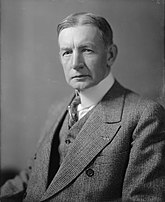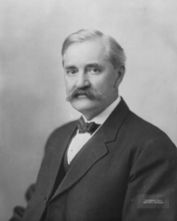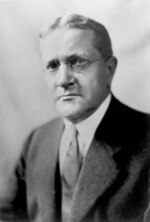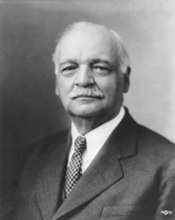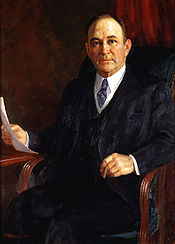69th United States Congress
| 69th United States Congress | |
|---|---|
68th ← → 70th | |
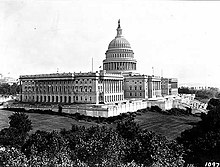 United States Capitol (1906) | |
March 4, 1925 – March 4, 1927 | |
| Members | 96 senators 435 representatives 5 non-voting delegates |
| Senate majority | Republican |
| Senate President | Charles G. Dawes |
| House majority | Republican |
| House Speaker | Nicholas Longworth |
| Sessions | |
| Special: March 4, 1925 – March 18, 1925 1st: December 7, 1925 – July 3, 1926 2nd: December 6, 1926 – March 3, 1927 | |
The Sixty-ninth United States Congress was a meeting of the legislative branch of the United States federal government, consisting of the United States Senate and the United States House of Representatives. It met in Washington, D.C. from March 4, 1925 to March 4, 1927, during the third and fourth years of Calvin Coolidge's presidency. The apportionment of seats in the House of Representatives was based on the Thirteenth Decennial Census of the United States in 1910. Both chambers had a Republican majority.
Major events
A special session of the Senate was called by President Coolidge on February 14, 1925.
- Impeachment of Judge George W. English — On April 1, 1926, the House of Representatives impeached Judge George W. English of the United States District Court for the Eastern District of Illinois. Both Houses adjourned on July 3, 1926, with the Senate scheduled to reconvene on November 10, 1926 as a Court of Impeachment. English resigned before the impeachment trial began. The Senate met as planned on November 10, 1926 to adjourn the court of impeachment sine die. On December 13, 1926 the Senate, acting on advice from the House managers of the impeachment, formally dismissed all charges against Judge English.
- January 17, 1927: U.S. Supreme Court held (McGrain v. Daugherty) that Congress has the power to compel witness and testimony.
Major legislation

- February 26, 1926: Revenue Act of 1926
- April 12, 1926: Timber Exportation Act of 1926
- May 8, 1926: Federal Interpleader Act of 1926
- May 20, 1926: Air Commerce Act
- May 20, 1926: Federal Black Bass Act of 1926
- May 20, 1926: Railway Labor Act (Parker-Watson Act)
- May 25, 1926: Omnibus Adjustment Act of 1926
- May 25, 1926: Public Buildings Act of 1926 (Elliot-Fernald Act)
- May 26, 1926: Shenandoah National Park Act of 1926
- June 3, 1926: Subsistence Expense Act of 1926
- June 14, 1926: Recreation and Public Purposes Act
- June 15, 1926: Limitation of National Forest Designation Act
- July 2, 1926: Cooperative Marketing Act
- July 3, 1926: Walsh Act
- July 3, 1926: Passport Act of 1926
- January 21, 1927: River and Harbors Act of 1927
- February 23, 1927: Radio Act of 1927 (Dill-White Act)
- February 25, 1927: McFadden Act (Pepper-McFadden Act)
- March 3, 1927: Foreign and Domestic Commerce Act of 1927
- March 3, 1927: Produce Agency Act of 1927
- March 4, 1927: Mayfield-Newton Act
Party summary

The count below identifies party affiliations at the beginning of the first session of this Congress, and includes members from vacancies and newly admitted states, when they were first seated. Changes resulting from subsequent replacements are shown below in the "Changes in membership" section.
Senate
| Party (shading shows control) |
Total | Vacant | |||
|---|---|---|---|---|---|
| Democratic (D) |
Farmer– Labor (FL) | Republican (R) |
|||
| End of previous congress | 42 | 2 | 52 | 96 | 0 |
| Begin | 40 | 1 | 55 | 96 | 0 |
| End | 42 | 53 | |||
| Final voting share | 43.8% | 1.0% | 55.2% | ||
| Beginning of next congress | 47 | 1 | 48 | 96 | 0 |
House of Representatives
- American Labor (AL): 1
- Democratic (D): 183
- Farmer-Labor (FL): 3
- Republican (R): 247 (majority)
- Socialist (S): 1
TOTAL members: 435
Leadership
Senate
Charles G. Dawes (R)
Albert B. Cummins (R), until March 6, 1925
George H. Moses (R), from March 6, 1925
- President: Charles G. Dawes (R)
- President pro tempore: Albert B. Cummins (R), elected March 4, 1925
- George H. Moses (R), elected March 6, 1925
Majority (Republican) leadership
Minority (Democratic) leadership
House of Representatives
Nicholas Longworth (R)
Majority (Republican) leadership
Minority (Democratic) leadership
Members
This list is arranged by chamber, then by state. Senators are listed in order of seniority, and Representatives are listed by district.
Senate
Senators were elected every two years, with one-third beginning new six-year terms with each Congress. Preceding the names in the list below are Senate class numbers, which indicate the cycle of their election. In this Congress, Class 1 meant their term began in the last Congress, requiring reelection in 1928; Class 2 meant their term began with this Congress, requiring reelection in 1930; and Class 3 meant their term ended with this Congress, requiring reelection in 1926.
House of Representatives
Changes in membership
The count below reflects changes from the beginning of the first session of this Congress.
Senate
- replacements: 7
- Democratic: no net change
- Republican: no net change
- deaths: 7
- resignations: 0
- contested election: 1
- interim appointments: 2
- Total seats with changes: 9
House of Representatives
- replacements: 11
- Democratic: 1 seat net loss
- Republican: 1 seat net gain
- deaths: 11
- resignations: 2
- Total seats with changes: 9
Employees
Senate
- Chaplain. John J. Muir (Baptist)
- Secretary. George A. Sanderson
- Edwin P. Thayer, from December 7, 1925
- Sergeant at Arms. David S. Barry
House of Representatives
- Chaplain. James S. Montgomery (Methodist)
- Clerk. William T. Page
- Clerk at the Speaker’s Table. Lehr Fess, resigned February 1, 1927
- Lewis Deschler, appointed February 1, 1927
- Doorkeeper. Bert W. Kennedy
- Postmaster. Frank W. Collier
- Sergeant at Arms. Joseph G. Rodgers
References
- ^ Frank L. Smith (R-IL) was elected to the Senate for the term starting March 4, 1927 and when McKinley died he was appointed to finish McKinley's term. The Senate refused to qualify him due to charges of corruption concerning his election. He would later resign. See http://bioguide.congress.gov/scripts/biodisplay.pl?index=S000534.
- ^ Exact date of Frank L. Smith's appointment to the Senate is unknown, but certainly between his predecessor's death on December 7, 1926 and the end of the term on March 4, 1927.[data missing]
- Martis, Kenneth C. (1989). The Historical Atlas of Political Parties in the United States Congress. New York: Macmillan Publishing Company.
{{cite book}}: Cite has empty unknown parameter:|coauthors=(help) - Martis, Kenneth C. (1982). The Historical Atlas of United States Congressional Districts. New York: Macmillan Publishing Company.
{{cite book}}: Cite has empty unknown parameter:|coauthors=(help)

